“Stop!” I said, as I instinctively threw my arms out to my sides in the universal language. The group came to an immediate stop. I pointed to a spot just three steps ahead directly in my path. There laid curled up a dark plump snake. Our guide for the day, Chris Crolley, Executive Director of Coastal Expeditions(1), recognized the animal right away and informed us we were looking at an eastern cottonmouth (Agkistodon piscivorus). The snake faced away from us, so it seemed unaware of our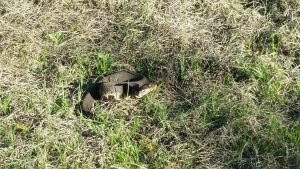 approach.
approach.
We were exploring Bulls Island(2), one of the protected barrier islands of the Cape Romain National Wildlife Refuge, an approximately 5000 acre island within a 66,000 acre wildlife refuge(3). This island is several miles from the mainland and totally undeveloped.
We repositioned ourselves to see the front of the snake and it did not move or even flinch. After giving everyone a good look, Chris picked up a stout stick and gave the snake a slight nudge. The snake raised its head giving us a good view of its characteristically triangular-shape. We could also see the underside coloration. Much to our surprise, Chris then gently pinned the snake with the stick and reaching just behind the head, he picked it up so we could see up close the 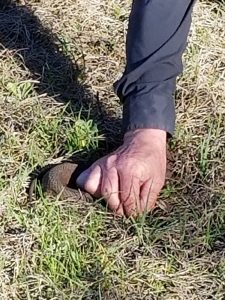 snake’s vertical slit eyes, eyes characteristic of v
snake’s vertical slit eyes, eyes characteristic of v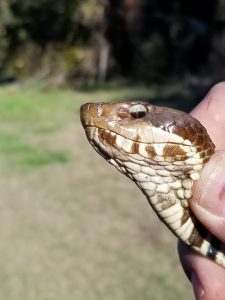 enomous snakes in the US. Chris gave us a good look at the top and the belly, noting how the belly plates did not
enomous snakes in the US. Chris gave us a good look at the top and the belly, noting how the belly plates did not 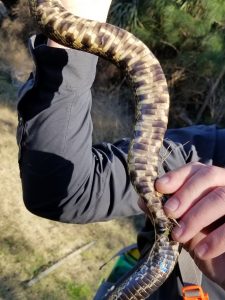 split at the anus, another identification characteristic of this species (only useful when one has a skin). Chris offered us a chance to touch the cottonmouth, keeping the face far from our hands. This also gave us a feel for the size of the animal, somewhere about two feet in length. Then Chris carefully placed the snake back on the ground so it could go about its daily business.
split at the anus, another identification characteristic of this species (only useful when one has a skin). Chris offered us a chance to touch the cottonmouth, keeping the face far from our hands. This also gave us a feel for the size of the animal, somewhere about two feet in length. Then Chris carefully placed the snake back on the ground so it could go about its daily business.
Having only seen cottonmouths once or twice in my life, this was a unique experience, but it also stimulated my naturalist’s desire to know more.
The scientific name, Agkistrodon piscivorus, translates to hooked tooth fish eater(5). This references the curved fang used to inject the venom into its prey and the prey being fish. In reality, while cottonmouths do eat fish extensively, they eat a much larger diet including frogs, mammals, birds, and even baby alligators. Usually associated with water our snake was on a dike near an area called Moccasin Pond. Another common name for this species is water moccasin. Wikipedia lists 34 different names for this snake, a good indication of this snake’s strong regional influence.
Our snake sat on the path nicely curled absorbing the solar energy in an effort to keep its body temperature warm.  Snakes are poikilothermic, a scientific term that is Greek meaning varied temperature. We used to call these animals “cold blooded.” In reality, they just do not have the ability to regulate their body temperature internally and dependent upon the temperature of their environment. One way to increase their body temperature is to sit in the sun, like our snake.
Snakes are poikilothermic, a scientific term that is Greek meaning varied temperature. We used to call these animals “cold blooded.” In reality, they just do not have the ability to regulate their body temperature internally and dependent upon the temperature of their environment. One way to increase their body temperature is to sit in the sun, like our snake.
Reputed to be aggressive, our snake never opened its mouth to show is the bright white mouth-lining from which this snake gets is common name. It never moved towards us and when released is slithered away. I suspect its behavior may have been different if I had stepped on it.
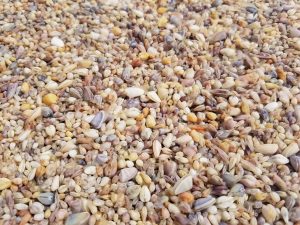 Our visit to Bulls Island included a long hike where we birded, and walked along the beach searching for shells. A cluster of coquina clams exposed around the base of one of the tree skeletons on the beach would make a challenging puzzle and gave us an idea of how common these tiny clams are.
Our visit to Bulls Island included a long hike where we birded, and walked along the beach searching for shells. A cluster of coquina clams exposed around the base of one of the tree skeletons on the beach would make a challenging puzzle and gave us an idea of how common these tiny clams are.
If you find yourself in South Carolina, this is a must see stop for dedicated naturalists. It is not a casual visit and requires a lot of walking, we did about 7 miles.
Resources
(1) http://coastalexpeditions.com/adventures/
(2) https://www.fws.gov/uploadedFiles/BullIslandTearsheet12.pdf
(3) https://en.wikipedia.org/wiki/Cape_Romain_National_Wildlife_Refuge#cite_note-1
(4) https://www.fws.gov/refuge/Cape_Romain/
(5) https://en.wikipedia.org/wiki/Agkistrodon_piscivorus

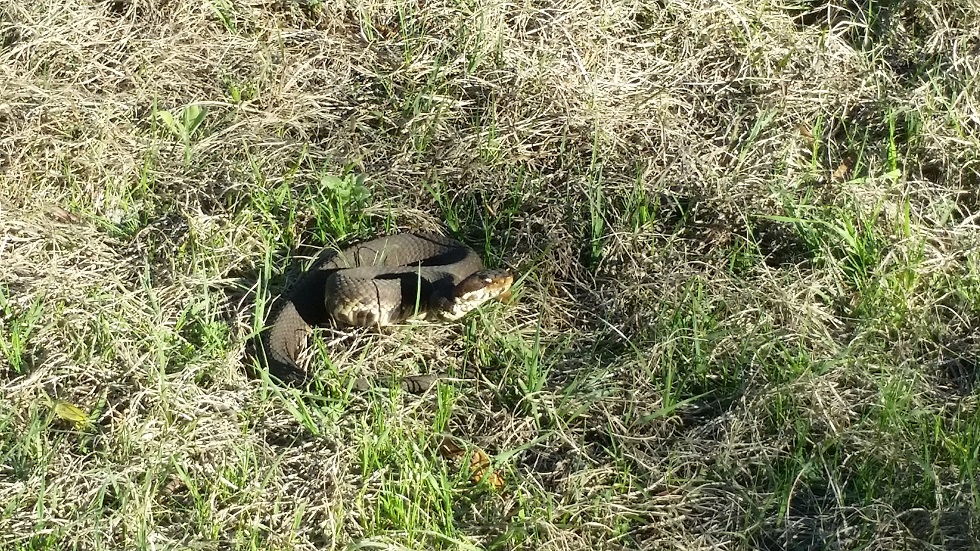
What a great adventure. And how lucky you were to be able to examine it.
Keep blogging!
excellent info, thanks for sharing
Hi Bob, Thanks again for an informative read. One thing to consider on the snakes lack of aggression, is that the snake was sunning trying to “warm up” and may not have been at optimal body temperature. (I’m not saying that they are normally aggressive because I have no experience with these snakes). Just a thought.
Dear Bob,
Thanks for the armchair view of a magnificent natural area. I am still looking everyday. P